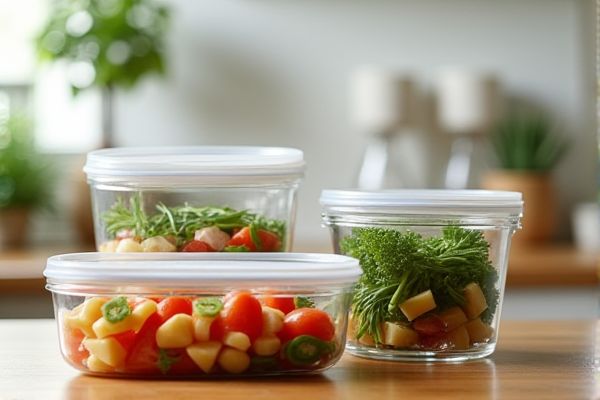
Plastic food containers offer lightweight convenience and are often more affordable, while glass food containers provide superior durability and do not retain odors or stains, making them ideal for long-term storage. Discover the key differences between these options to determine which best suits Your kitchen needs and lifestyle in the full article.
Table of Comparison
| Feature | Plastic Food Containers | Glass Food Containers |
|---|---|---|
| Material | Various plastics (polypropylene, polyethylene) | Tempered or borosilicate glass |
| Durability | Prone to scratches, warping, and staining | Resistant to stains and odors, breakable but durable when tempered |
| Safety | May contain BPA or phthalates; check labels for food-safe certification | Non-toxic, BPA-free, safe for food storage |
| Microwave Use | Generally microwave-safe; verify manufacturer guidelines | Safe for microwave heating |
| Freezer Use | Suitable but may become brittle over time | Excellent freezer-safe option without cracking |
| Weight | Lightweight and portable | Heavier and less portable |
| Environmental Impact | Non-biodegradable, often single-use, less eco-friendly | Reusable, recyclable, environmentally friendly |
| Cost | Generally lower initial cost | Higher upfront cost but longer lifespan |
| Cleaning | May retain odors and stains; dishwasher safe depending on type | Easy to clean; dishwasher and stain-resistant |
Introduction to Plastic vs Glass Food Containers
Plastic food containers offer lightweight, affordable, and durable storage options, making them popular for everyday use and on-the-go convenience. Glass food containers provide superior non-toxicity and resistance to staining and odors, ensuring your meals remain fresh and uncontaminated. Choosing between plastic and glass depends on your needs for safety, longevity, and ease of maintenance.
Material Composition and Safety Concerns
Plastic food containers are typically made from polypropylene, polyethylene, or polycarbonate, which can release harmful chemicals like BPA and phthalates, especially when heated or scratched. Glass food containers, composed of borosilicate or soda-lime glass, are non-reactive and free from toxic chemicals, making them safer for long-term food storage and reheating. The inherent chemical stability of glass reduces risks of contamination and health concerns associated with plastic leachates.
Durability and Longevity Comparison
Plastic food containers offer high impact resistance and are less likely to break when dropped, making them durable for everyday use, but they tend to wear out faster due to scratching and staining. Glass food containers provide superior longevity with resistance to stains and odors while maintaining structural integrity over time, although they are more fragile and prone to cracking or shattering upon impact. Choosing between the two depends on prioritizing either the shatterproof durability of plastic or the long-term, non-reactive lifespan of glass.
Environmental Impact and Sustainability
Plastic food containers contribute significantly to environmental pollution due to their non-biodegradable nature and reliance on fossil fuels for production, leading to increased carbon emissions and landfill waste. Glass food containers offer superior sustainability as they are recyclable, reusable, and made from abundant natural materials, reducing long-term environmental footprint. Lifecycle assessments reveal that glass containers, despite higher manufacturing energy, ultimately result in lower overall environmental impact when reused effectively.
Cost-Effectiveness Analysis
Plastic food containers generally offer greater cost-effectiveness due to lower manufacturing and retail prices compared to glass containers. They are lightweight, reducing shipping costs and minimizing breakage losses, which further enhances their economic appeal. However, glass containers provide long-term savings through durability and reusability, often offsetting their higher initial investment over time.
Convenience and Usability in Daily Life
Plastic food containers offer lightweight, shatter-resistant convenience ideal for on-the-go meals and easy storage, making them a practical choice for busy lifestyles. Glass food containers provide superior durability and temperature resistance, allowing safe use in microwaves and ovens, enhancing usability for reheating and cooking. Your choice depends on the balance between portability and long-term durability for everyday food storage needs.
Food Preservation and Freshness
Glass food containers offer superior food preservation and freshness due to their non-porous surface, which prevents odor absorption and chemical leaching, ensuring food tastes as intended. Plastic containers, while lightweight and convenient, are prone to scratches and microabrasions that can harbor bacteria and compromise freshness over time. Studies reveal that glass maintains food quality up to 50% longer compared to plastic, making it a better choice for long-term storage and maintaining nutritional integrity.
Cleaning and Maintenance Requirements
Glass food containers offer superior cleaning and maintenance ease due to their non-porous surface that resists staining and odors, making them dishwasher-safe and less prone to retaining food residues. Plastic containers often require hand washing and thorough drying to prevent bacterial growth, with some materials susceptible to scratches and discoloration over time. Choosing glass improves durability and hygiene, while plastic demands more careful cleaning routines to maintain safety and appearance.
Microwave and Oven Compatibility
Glass food containers offer superior microwave and oven compatibility as they can withstand high temperatures without warping or releasing harmful chemicals. Plastic containers often contain BPA or phthalates, which may leach into food when heated, and many are not safe for oven use due to their low melting points. Choosing glass containers enhances the safety and durability of your food storage, especially when reheating or cooking meals.
Summary: Choosing the Right Food Container
Plastic food containers offer lightweight convenience and affordability, while glass containers provide superior durability, non-toxicity, and better resistance to stains and odors. Your choice depends on factors like storage duration, microwave use, and environmental considerations. Prioritizing glass containers often benefits long-term health and sustainability efforts.
 homyna.com
homyna.com